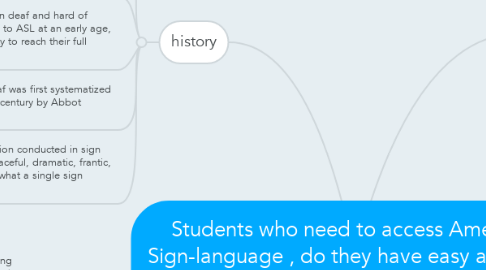Students who need to access American Sign-language , do they have easy access to it?
by Amber Mott

1. history
1.1. Statistics tend to show a success gap between "hearing students" (students without hearing loss) and deaf students in public schools.
1.2. Sign language is not a universal language -- each country has its own sign language
1.3. Studies have shown that when deaf and hard of hearing children are exposed to ASL at an early age, they are given the opportunity to reach their full potential.
1.4. Sign language for the deaf was first systematized in France during the 18th century by Abbot Charles-Michel l'Epée.
1.5. A casual observer of a conversation conducted in sign language might describe it as graceful, dramatic, frantic, comic or angry without knowing what a single sign meant.
2. things to know
2.1. To communicate with a Deaf/hard of hearing student, maintain eye contact and address the student directly.
2.2. Some people confuse ASL with "Signed English." Much of the vocabulary is different.
2.3. In sign language most signs do not suggest, or imitate, the thing or idea they represent, and must be learned.
2.4. The interpreter is most often seated in front of the class, opposite the Deaf/hard of hearing student, and will try to maintain a position that allows the student to see the speaker and the interpreter at all times.
2.5. ASL is a natural, visual, non-spoken language with its own distinct grammatical structure.
2.6. The three classes of features that make up individual signs are hand configuration, movement, and position to the body
2.7. The inherent capability of children to acquire ASL should be recognized and used to enhance their cognitive, academic, social, and emotional development.
3. access
3.1. sociological study outlines texts that originate between users and interpreters and how they can be used to develop VRS access.
3.2. access for deaf people can be considered more complex than video relay service
4. fun facts
4.1. Learning American Sign Language is fun and can open the door to a new world of friends and interesting people.
4.2. Wherever there are communities of deaf people, you'll find them communicating with a unique vocabulary and grammar.
4.3. It is possible to sign without using facial expressions or body movements, but doing so may give a mixed message, be confusing, or be misunderstood
4.4. Learning ASL also opens possibilities of working with Deaf people in the community while expanding your personal horizons.
4.5. A number of written systems for representing manual languages have been developed, and dictionaries of signs have been compiled.
5. questions
5.1. Why do hearing students often achieve more in school than students with hearing loss?


